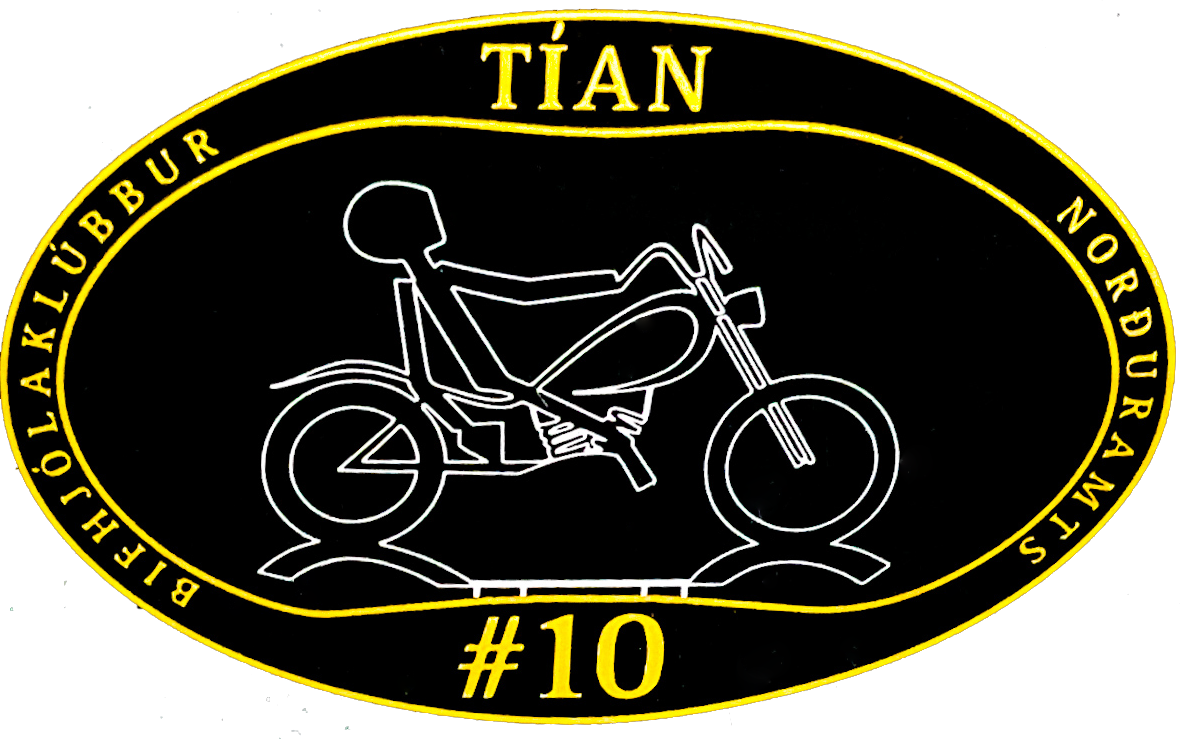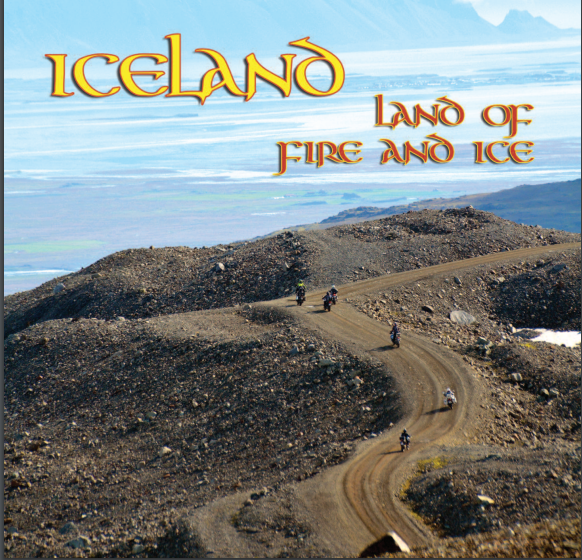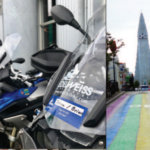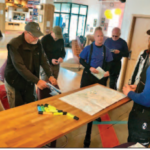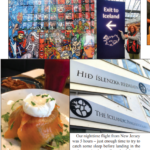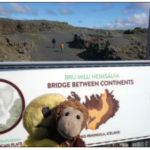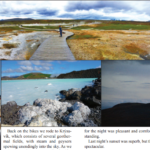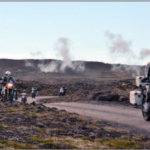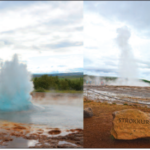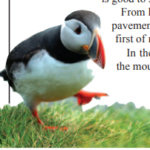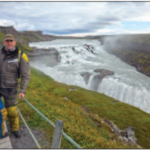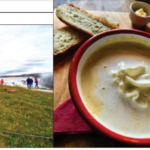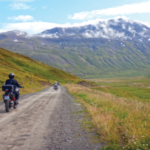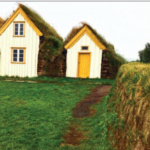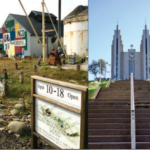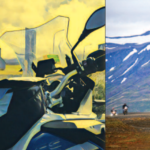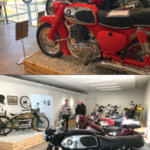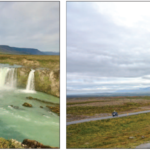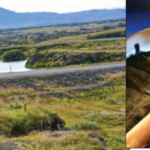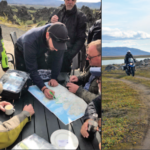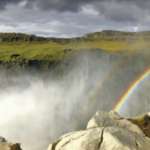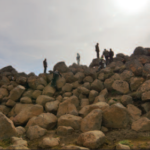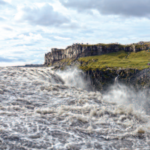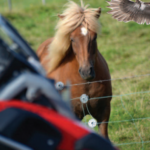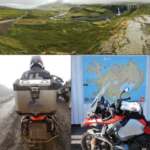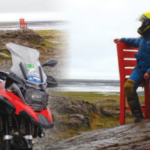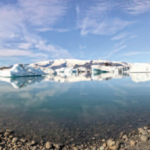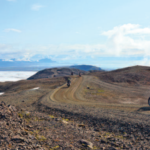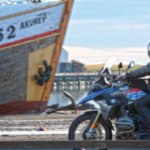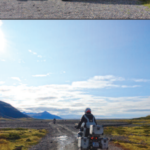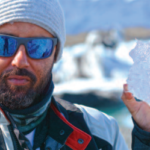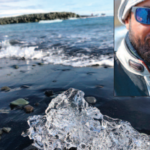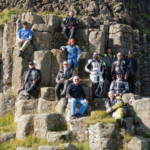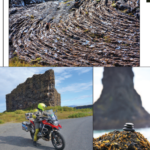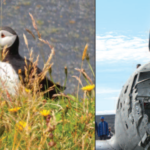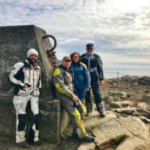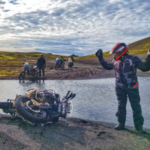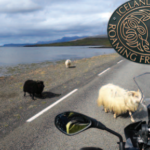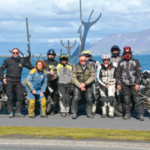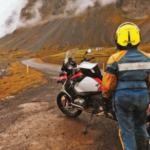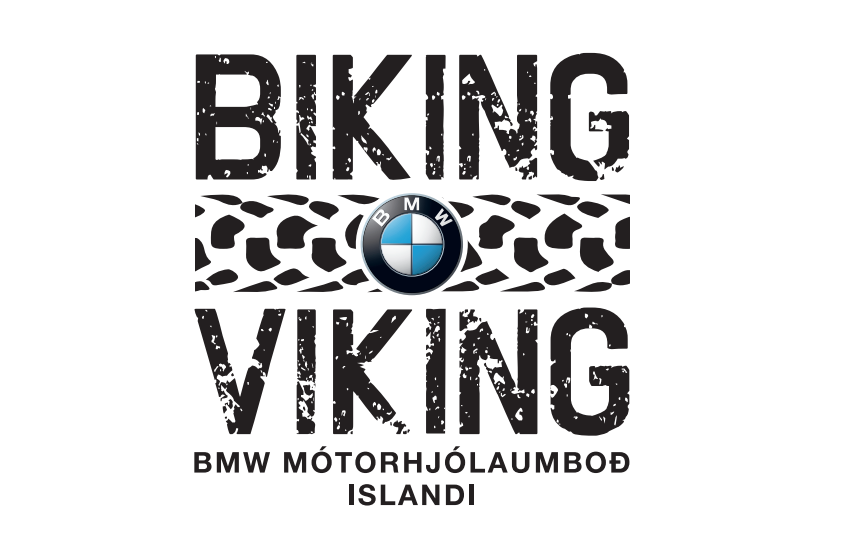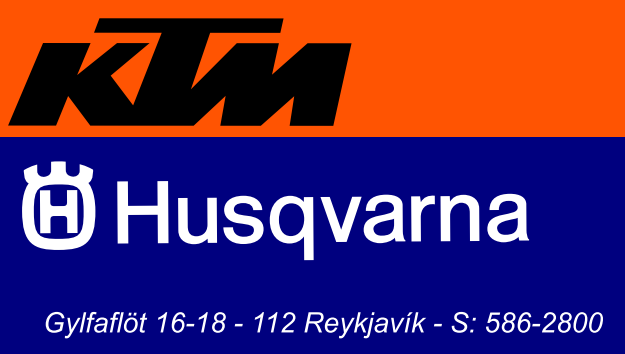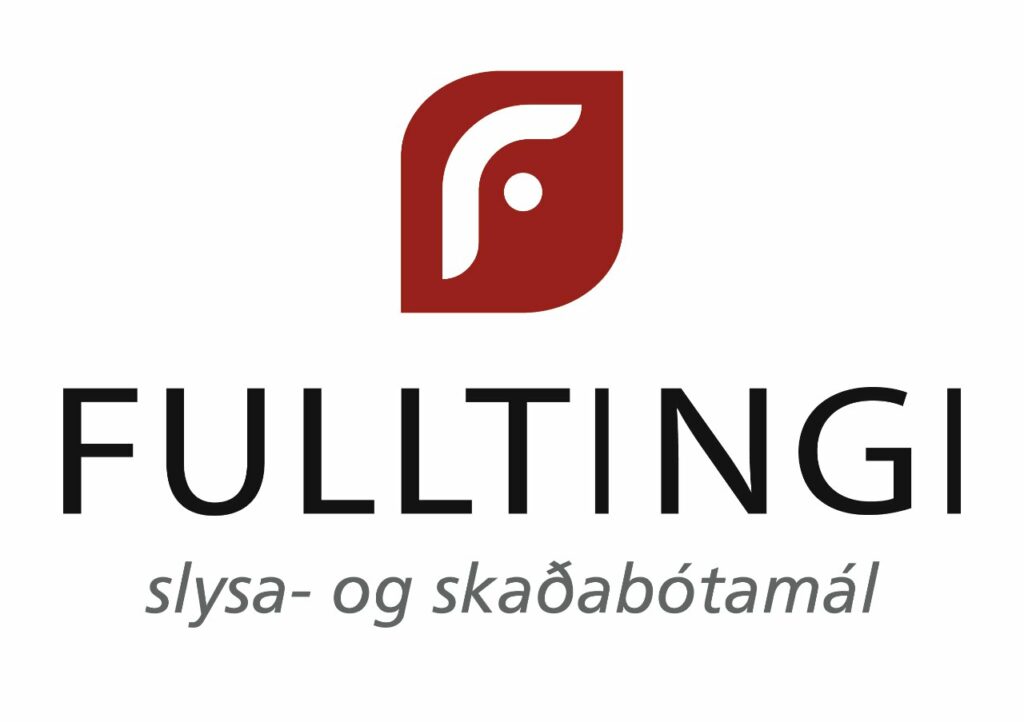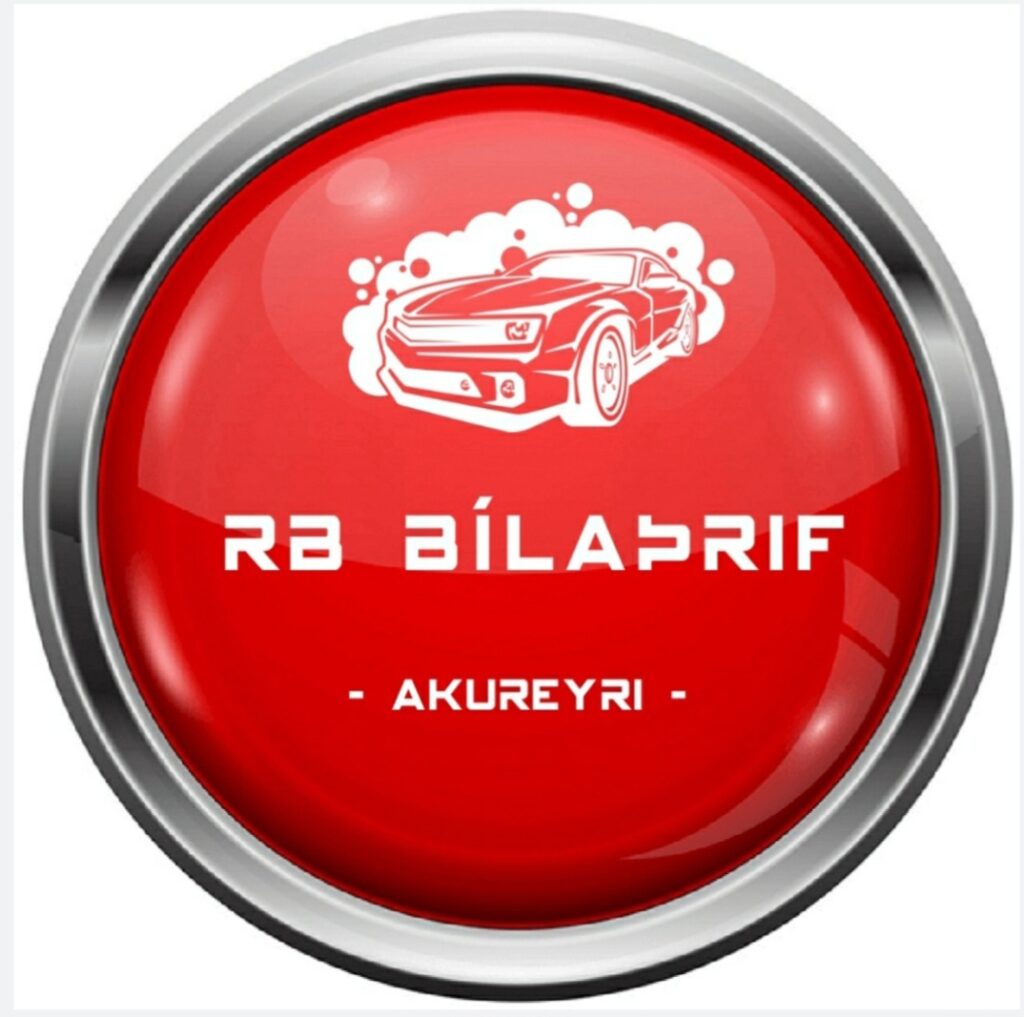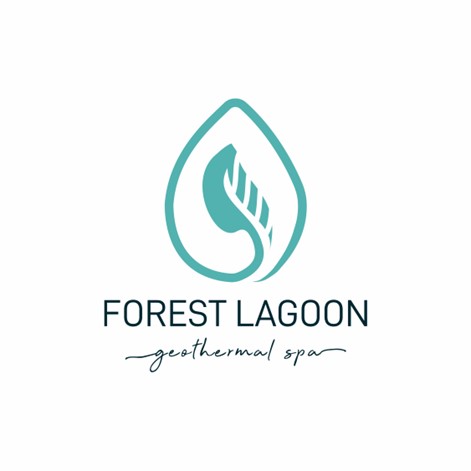„We come from the land
of the ice and snow
From the midnight sun,
where the hot springs flow
„The Immigrant Song – Led Zeppelin,,
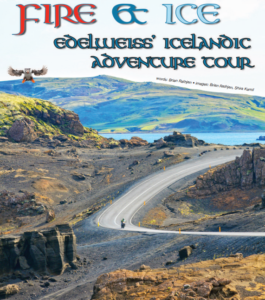 To Reykjavik, Iceland
To Reykjavik, Iceland
In the center of the north Atlantic, just below the Arctic Circle, at the confluence of the North American and European continents, there is an island
nation that has a long history of exploration and progress.
About the size of the state of Maine, the Icelandic landscape is shaped by
the forces of nature and vary from deep fjords to vast volcanic deserts, gushing geysers, natural hot springs, as well as lava fields spreading as far as the
eye can see.
Iceland’s nature remains mostly unspoiled as the island is scarcely populated – with just 340,000 humans calling her home, 60% of those living in
and around the capital Reykjavík that occupies a little over 1% of the total
size of Iceland.
Our nighttime flight from New Jersey
was 5 hours – just enough time to try to
catch some sleep before landing in the
early morning hours (2 am back home)
and shuttling the 30 miles to the northernmost capital in the world.
Our room was not ready, so we stowed our gear and took off for a morning
walk about Reykjavík. The city reminded me of many coastal working towns,
(Ushuaia came to mind) with many low buildings and narrow streets and surrounded by stunning scenery that seemed to stretch for miles – which it did,
as we would see on this journey.
We found a small local restaurant where we had a breakfast sample of local
smoked trout, salmon and eggs before continuing around the town. There
was plenty to see.
Always on the lookout for the ultimate cultural offerings a city would have,
I talked Shira into a visit to the Icelandic Phallological Museum. Home to
the greatest collection of penii in Europe, perhaps the planet, with more than
200 penii and penile parts belonging to almost all the land and sea mammals
that can be found in Iceland, including whale, polar bear and, yes, human.
One for O’Life I am sure.
From there we thought we should go to church. In a land of low and tiny
churches the Hallgrímskirkja, standing at nearly 250 feet tall, is the largest
and tallest church in Iceland, and it dominates the Reykjavík skyline.
We strolled to the waterfront, and past the Sun Voyager sculpture by Jón
Gunnar Árnason. Although you might first think this a Viking long ship it was really designed as
an ode to the sun and as
a dreamboat for the
viewer. Heading back
along the Old Harbor
we passed the Harpa,
Reykjavík’s new concert hall, created from
steel and colored glass
to depict the basalt Icelandic landscape. Very beautiful – now that the sun
was peaking out.
We returned to the hotel to find our rooms and a deep naptime waiting.
Our group consisted of a number of Americans, one German and a rider
from Kuwait. We met in the lobby that evening where our Edelweiss guides,
both named Michael (one was shortened just to Mike), gave us an overall
briefing on the tour: what to expect and the various road surfaces we would
encounter. Most of Iceland’s roads are gravel, so we’d be doing a lot of unpaved riding along this tour.
After taking the keys to our ride for the next 10 days – a BMW R1200 GS
Adventure – we had a welcoming meal and then Shira and I strolled to the
west side of the harbor to watch the Icelandic sunset at 9:30 that night.
Reykjavik to Selfoss
There were a few small issues that needed tending to on a few of the bikes
this day, so while the Mikes handled all that, we took a leisurely breakfast
and, by mid-morning, we were all geared up and rolling out of Iceland’s capital.
Our ride would bring us south and west towards Reykjanesskagi peninsula
and one of the most active volcanic parts of the island nation. We rode for
miles through lava fields, with the terrain looking almost alien.
Our first stop was the point of two titanic forces of nature meeting – the
Eurasian and North American tectonic plates. Here the mid-Atlantic ridge
runs directly under Iceland and you will find a small footbridge that crosses
over a fissure in the blackened land. The bridge was built as a symbol for the
connection between Europe and North America.
Certainly a ‘digital’ moment if there ever was one.
Back on the bikes we rode to Krýsuvík, which consists of several geothermal fields, with steam and geysers
spewing unendingly into the sky. As we
rode closer the strong smell of sulfur
filled the helmets. I wondered to Shira what was the attraction for the Norse
back when they settled this place? The ground, where not strewn with volcanic debris, took on yellow, red, and green hues and was hot to the touch.
In the distance we could see a lighthouse and far behind that – Eldey – a
sheer massive rock skerry that rises hundreds of feet out of the ocean and is
home to thousands of Gannets and, Shira would hope, Puffins.
We walked to and through the steady plume of steam – getting fairly well
soaked as we did.
Our guide, Michael, brought us along the coast to a small restaurant that
served some seriously tasty soups – lamb or lobster – and then we swung
back to the Blue Lagoon – which is pretty to see, but was a bit too trendy,
touristy and hip for our tastes.
We followed along through the lava fields and made a stop at Seltún, another geothermal highlight with a path and boardwalk meandering through
dozens of mudpots and fumaroles. As you would think everything was well
marked as hot and dangerous – yet all were free to explore as we wished – it
is good to see common sense instead of common fence.
From here the road got twisty and fun, with pristine
pavement unti that came to an end and we rode into the
first of many miles of gravel road.
In the distance, way in the distance, we could see
the mountains still heavily snow covered.
The ice part of Fire and Ice was coming as we rode into what Icelanders
call ‘The Golden Circle.’ Our lodging
for the night was pleasant and comfortable and the hotel’s restaurant outstanding.
Last night’s sunset was superb, but this night’s ‘Deathstar” half moon was
spectacular
Selfoss to Saudarkrokur
I know what your thinking… How do you pronounce Icelandic names?
Beats us, so when we were traveling alone we had a card with written directions and did our best phonetically.
We would make a few more geothermal stops on this day – the first being
Geysir. Here it is pronounced ‘gayser’, not ‘geyser’ as we do.
Michael told us the old gayser used to shoot very high into the air, but has
not for many years due to an earthquake shifting the ground underneath, but
the much younger gayser could spurt many times each hour.
Well, goody for him.
We all passed looks at each other as our guide continued – trying not to let
out a peep. I thought I would drop from not laughing.
In truth the region was the first geyser to be described in a printed source
and the first known to modern Europeans and the English word geyser derives from this point.
The younger of the geysers – amusingly called
Strokkur (it means churn,
stop laughing) – did erupt
many times while we were
there, throwing steam and
hot water nearly 75 feet
into the air.
Another true wonder on
this day’s meander was the Gulfoss, one of the most magnificent waterfalls either of us had ever seen.
Fed by the Langjökull glacier the Hvítá, or White River’s, water plummets
down 100 feet in two stages into a rugged canyon whose walls reach over
200 feet in height. The story of Sigriður Tómasdóttir and her fight to save
this mighty waterfall over 100 years ago has become an Icelandic legend and
is well worth reading.
This day’s journey, and it was a journey, would cut up directly from the
south to the northern part of Iceland, mostly through heavily volcanic regions
flanked with glaciers and along the first of many F-roads.
Iceland’s F-roads are mostly a lane and a half of gravel and/or rock, with
old chunks of volcano added in to make it even more enjoyable.
Here the F is either for ‘Fun’ or F#!*ked, depending on your attitude and
skill level.
It seemed to me that we were in the company of some excellent riders and
with Shira and I two-up, on a machine with a nearly 8-gallon fuel cell, we
wisely stayed in the back, not looking to get in anyone’s way and to set our
own pace.
We learned a long time ago that you don’t have to go fast… just far.
For those who know us, you’re aware we are not timid of gravel and the
like – when it is a part of the ride. But, on this day and a few others of the
Fire & Ice Tour, the gravel and off-road adventure ‘was’the ride and most of
the riders who were here came along to ride gravel in one of the most wondrous regions on the planet. Edelweiss certainly came through on this.
We stopped at another geyser
system called Hveravellir, nestled between the two glaciers,
Langjökull (Long) and Hofsjökull (Temple) that had been
our riding companions for a
good part of the day. We
strolled around the tiny pools
of bubbling waters and fumaroles, all with the now familiar perditions’ stench, and
lunch was simple, but filling.
Still, the 100 miles of this began to
wear on many of us, and after lunch it got
a bit worse as one sharp rock had sliced
through the tire and tube of one of the F
800 GS’. Guide Michael tried in vain to repair it, so we eventually ended up
swapping a bike and having one of the group lead by GPS toward the hotel,
which was still another 50 hard miles north. All this while we saw the temperatures drop steadily as we made our way north.
As the Edelweiss van circled back to retrieve Michael and the now lame
machine, Shira and I let the group head out and took our own pace along
some spectacular scenery. There was even a good 20 miles stretch of decent
graded gravel and I found the bike did have a 4th gear.
Along the way we were passed by Mike in the van and soon crossed a onelane miniature version of the Brooklyn Bridge onto the Ring road towards
the town of Sauðárkrókur where our room and a hot soak in the thermal pool
was waiting.
Saudarkrokur to Akureyri
The hammer of the gods
We’ll drive our ships to new lands
To fight the horde, and sing
and cry Valhalla, I am coming!
This day, compared to the previous, would be short on miles but big on
smiles as we would stick, more or less, to the coast on a mix of finely paved
roads that, on occasion, turned into gravel along the cliff side that tends to
tumble down onto the road every now and again. Unlike the previous days
that saw fair weather, this morning the Norse Gods frowned upon us as the
now colder temperatures were mixed with a chilling mist as well.
We had brought heated gear with us and today was the day to put it to use.
On the way we stopped to view some olden Icelandic
buildings constructed of peat moss and thatched with
growing grass on the roofs – this is considered by many
as the purest example of ancient Icelandic
architecture and they were built exactly
as the Norse settlement we rode to at
L’Anse aux Meadows in the north of
Newfoundland last year.
We swung around the fjord under
brightening skies on some seriously fun roads that hugged the coast with great sweepers and greater views.
We stopped for some coffee at the old Immigration House and to take
in the coast before pushing onward to the old fishing village of
Siglufjörður – once the herring capital of Iceland before overfishing collapsed it in the late 1950s. Although the town itself has diminished in
population of the last few decades, they still embrace their fishing heritage and the museum was well
worth the stroll through.
We took lunch along the water – with a mix of seafood salads, a taste of herring and the best ‘fried
potatoes’ we have ever had.
Our group seemed to be happy to run at Marquez-pace this day and that was never our plan, so we
split off from them and took a more leisurely ride back along the ocean and then along a stunningly
beautiful gravel road that cut through a low mountain pass towards the small town of Ólafsfjörður.
This town was reachable only by sea or by the pass road we had just ridden until a few decades back
before the series of tunnels were cut through the mountains.
Still today the town exudes a wonderful Icelandic charm and is the only village I have ever seen
with its own public ski jump in the middle of the town park.
We caught up with the group as we entered Akureyri and then rode over to the Motorcycle Museum
of Iceland, which was far more impressive then we thought it would be, with an eclectic collection of
machines from different eras and nations. Many of them looked like runners and were probably machines you might have ridden or owned in the past.
We finished the day under, once again, clear skies, took our hotel room and headed out to explore
Akureyri, the second largest city in Iceland and considered by many as the prettiest. We walked the
town and climbed the 100 plus stairs to the church with its commanding view of the town and then
found our way to the botanical gardens which, even in mid-August and this far north, were very impressive.
Shira spent some time scanning the waters and cliffs – although I did not know why.
“Whatcha lookin’ for?” I asked.
“A puffin” she said – sadly shaking her head and walking away.
Akureyri to Husavik
We once again lucked out with very un-Icelandic weather and we headed to
another spectacular waterfall called Godafoss.
Here the waters of the Skjálfandafljót river crash into the volcanic rocks in an
impressive fashion. But there is deep Icelandic religious history to be found here.
Amillennium ago Iceland was very limited in trade with other parts of Europe as they were still worshipping the Norse Gods of old – and the rest of
Christian Europe wanted little to do with them.
So, in the year 1000 the Lawspeaker Thorgeir Thorkelsson made Christianity the official religion of Iceland. After his conversion Throkelsson threw
his statues of the Norse gods into the Godafoss’ tumbling waters.
Although this was done symbolically and the people still worshiped whom
they wished, it opened Iceland up to more and faraway trade. This led to the
second major factor in the lawspeaker’s decision; that Iceland was then part
of Norway and King Olaf Tryggvason had recently become a Christian. The
King’s conversion meant that many Icelanders decided they, too, would convert, thus threatening a civil war in the country. Thorkelsson’s decision to
forgo his own beliefs was seen as a means of avoiding said violence, with
the stipulation added that Icelanders were still free to worship the Norse
Gods, as long as it was undertaken in secret. Today Iceland is a Christian island, but in its heart and soul they still live under the watchful eyes of Odin.
We then made a, thankfully, brief stop at the truly named place along a
large shallow lake and then for a coffee stop along the odd volcanic formations. Although there are no mosquitoes in Iceland they do have a pest – the
midge – a tiny flying insect that is as Icelandic as the puffin or the sheep. The
lake Mývatn is named after them, its name literally meaning “midge lake”.
Beautiful – now let’s go.
It was here that the band broke up. Some headed on a long 300+ kilometer
ride to the northernmost point on the island, others around another mountain
pass to approach our night’s layover in Húsavík from the east, while Shira,
a few others and I followed another road that would, eventually, approach
from the west.
We knew that a good deal of this would be unpaved, but so far so good,
and we were not concerned. We might have been, as Iceland’s gravel roads
are one thing, but their construction zones are another beast entirely.
After about 10 miles of tightly packed 4th gear gravel I came over a rise
into a long stretch of deep baby head rocks. I quickly tried to down shift,
scrub off some speed, and
then get up on the pegs
and back on the gas.
Eyes up, heart pounding. This route had a series of these baby head
stretches that went on for
far too long for my liking.
But, we all muddled
through – even though it
weren’t pretty.
We rolled into Húsavík
by early afternoon, found
a super harbor side lunch
and then some went whale watching, while the others took in the
Whaling Museum, which was fascinating by itself, although Shira
was deeply disappointed in not seeing a live Puffin. I was not
aware of my wife’s Puffin fascination, but it is always nice to be
surprised.
By that evening the band was back together, with all having a story to tell. Humpbacks and Blue Whales, deep sand traps and
mountains that needed to be ridden to the top
of… it is all part of the allure of a motorcycle
journey like this. There were no Puffins. Sigh.
Husavik to Egilsstadir
We would leave our furthest point north and ride to our most eastern town
on the trek – Egilsstadir; a town that has its own lake monster and, if you
read Backroads, you know we will not leave this out.
But first we’d ride across the Mid-Atlantic Ridge once again, this time
from the North American to the Eurasian continents at Ásbyrgi. Here lives
the 15-mile long Jökulsárgljúfur, or Glacial River, Canyon in the northeastern
part of Iceland. The canyon is beyond stunning and horseshoe in shape, about
a mile across with tower cliffs of nearly 400 feet. Throughout thousands of
years, the river has shaped its path with water and devastating floods from
the melting glacier in times of eruption and still changes to this day with Ice land’s volatile eruptions and activity.
This sits just a short gravel road ride from the series of waterfalls including
the monstrous Dettifoss. It seemed each day there would be a waterfall, or
Foss, of the day. Here it was like the Grand Canyon had met up with Niagara
Falls – it was almost beyond words.
Easily the most powerful waterfall in all of Europe (some might say it is
right up against North America, but I am splitting hairs here) it dumps over
150,000 gallons of water over its edge… per second!
Almost as equally amazing is that you can walk right
up to this torrent and touch it. Again, unlike here in the
USA, there is a “common sense, not common fence” approach. In the United States there would be a gate, a hefty
entrance fee, a bus and a lawyer all on stand-by.
From here we spent a good part of the day riding high
atop the ancient volcano desert which gave us the feel of
journeying along some alien world.
Mike brought us up along some two-track – that
seemed to get tighter and slicker – which really pleased
us to no end. But, the payoff was worth it and there was
even another side trip up a few miles of rock track to a
long pile of glacial terminal moraine, sitting like a large
boulder wall built by some Asgardian Titans of the past.
One of the group had no desire to attempt the rock track and neither did
Shira, who hopped off the GS and let me go play with the other kids for a bit
– Thank you honey!
We picked the Ring Road back and swung at a steady and quick pace on
the paved road to the town of Egilsstadir – home of Lagarfljótsormurinn, the
Wyrm of Lake Lagarfljót!
This beast, or whatever
it is, has been reported
since Europeans arrived in
Iceland, with documented sighting
starting in 1345 all the way to a very
convincing video shot in 2012.
We’ll have to see what O’Life has to say about this.
While I asked about the Wyrm, Shira inquired about
the chance of any Puffins along the lake. We were told
that they are sea birds and wouldn’t be found along the
mountain lake.
She walked away defeated by the lack of the cute little fowl, but her spirits were lifted by a number of Icelandic horses – tiny, pony-size and far too cute and
good looking – these horses look like they were designed by a 7-year old little girl.
Egilsstadir to Hofn
Once again it seemed that the shorter days were big on adventure.
This was the first day we’d have true Icelandic weather along for the ride
all the day. Misty, wet, cold – we all suited up accordingly.
We looped the long lake ever searching for the Wyrm, but saw massive
volcanic cliffs, laced deep with iron ore. Our group chose a ‘short cut” over
the mountain called the Oxi Pass.
The road to the summit is called Axarvegur and it is a narrow and steep
gravel mountain road with sections up to 17% grade. We zigzagged our way
up along this way that rode in and around dozens of steep waterfalls and some very striking scenery of rocks, boulder, hawkweed, wooly willow and eventually into the deep clouds. This is where things got a bit more interesting as it was
just Shira and me, as we tend to hang back from the crowd, and soon we were slicing into the mists that shrouded the peaks and into the riding equivalent of a twowheeled Twilight Zone.
Yep, this was adventure… we think.
We were high atop an ancient mountain in the middle of Iceland, with zero visibility, soaking conditions and a wet, slick and questionable road surface with a series of tight turns approaching as we descended.
I wondered aloud if this was the worse we had ever ridden through.
Shira responded to me over the intercoms that it could be worse – at least this
time there were no gale-force winds trying to knock us down, that we had heated
gear and the bike was still going forward!
But, we still had to worry about the occasional car heading our way, as they would
appear from nothingness and were, more or less, in the same boat as us. Things got
clearer on the easternside and we picked up the Ring Road once again that had
large sections of unpaved surface as well. Here the Earth moves so much in spots
that paving is simply futile.
We took lunch along a seaside restaurant and then headed south.
Thousands of seabirds call this region home, with the Norwegian Sea to
the east and the mighty cliffs to the west above the shore. Miles of Whooper
Swans and Arctic Skua and Terns filled the ocean and the cliffs.
We rounded one sweeper and I watch an Arctic Tern banked its flight and
headed across the road – on a collision course.
There was nothing I could do as the sea bird came in from the right and
slammed into the bike with an explosion of bird and feathers.
The bike took a slight wobble, but we had momentum on our side.
We made a U-turn, but knew what we would find.
I apologized to the Icelandic gods and rode a bit less enthusiastically for a
long while – deeply thankful that it was not a Puffin.
Just before the next town we spotted ‘The Red Chair’ bolted high on a tall
rock on the coast side of the road – one of those odd roadside things that people do for whatever reason. We read about it on Atlas Obscura and it brought
back the happy mood that had flown west with the dead Tern. All was good
again in the land of Fire & Ice.
We reached Höfn on the early side and took to exploring the coastal town
that lies in the shadow of Europe’s largest glacier, Vatnajökull, and volcanoes
that live beneath her.
One in particular, Grímsvötn, had erupted repeatedly in modern times and
it was because of this that it took Iceland decades to complete the Ring Road.
This volcano is second in size only to Sicily’s Mount Etna.
Grímsvötn has erupted again and again and with the eruption comes the
possibility of the real danger along the eastern parts of this island, a jökulhlaup. This is an incredible torrent of melted glacial waters that can burst from
the eruption, larger in volume than any river on the planet save the Amazon,
that simply sweeps through the plains below taking all in its path. It is an
ever-perilous situation.
Hofn to Kirkjubaejarklaustur
Vatnajökull is enormous, grabbing 1/8 of the map of Iceland. We first did
a short ride to one part, to see the glacier up close, but then Edelweiss had
bigger plans for those who wished.
Just south of the town of Höfn was a road that would wind about 15 miles
up towards a part of the Vatnajökull that reached down towards the sea. The
truck would stay behind, as would Shira. Unlike any of the other excursions,
on this one the guide would ride shotgun, just in case there was trouble.
I would think everything on this trek led up to this ride to the top of the mountain and the waiting
Vatnajökull.
First and second gears,
driving ever upward…
steep inclines and hairpins
leveled out to a plain with
more gentle slopes. My
thought was not to think
on the entire ride up the
mountain but, rather, take
it in chunks and kick the
ball, or the bike, down the
road with each one.
Atop the peak the view
opened up to a long tongue
of the Vatnajökull.
There was a building
atop the mountain and
there was even snowmobiling onto the glacier for
some lucky folks.
The enormity of this
place quickly sunk in and
taking a deep breath and
scanning the ice, the sky
and land, as corny as it
sounds, I felt I had finally
ridden into Iceland.
On the way down the
group rode ahead, kind
enough to let me play photographer, and I rode the
15 miles back down by
myself, which was a bit tougher than the charge up. Eventually Happy &
Pepe told me to stop taking pictures, or I’d never get down to the Ring Road.
Unlike my wife, my new best friends on the planet waited for me to ride
out and we charged south to the Glacial River Lagoon, called Jökulsárlón (I
had long given up on pronunciation) the still, blue waters are dotted with icebergs calved from the glacier. The Glacier Lagoon flows through a short waterway into the Atlantic Ocean, leaving chunks of ice on a black volcanic sand beach. In winter, the fish-filled lagoon hosts hundreds of seals. Even here
in August the seals abounded and, as always, were a highlight.
Shira went fishing for a chunk of ice
and came back with a beauty; tasting
water that had frozen thousands of years
ago was fairly amazing and we brought
the large chunk back to the hotel for cocktails later that night.
We had two more stops – one we could have done without as it involved a
bombed out road to another part of the glacier that had more craters than the moon.
I felt like I was riding through a war zone, but the real victim was Shira who had
to hold on as the BMW’s suspension got tested to its limits.
The cliffs are hexagonal columns of basalt, topped with cube-jointed basalt,
shaped like a horseshoe. Inside the cliffs are home to both dwarves and elves, according to folklore. But, mind you, quite a number of Icelanders still believe it to
be true and the rest can’t prove it isn’t.
So there you go.
By late afternoon we made our way to Kirkju…. Kirkjubæ…K-Town, our stop
for the night.
Outside our hotel there was a small building with a round dome, flanked by two
flashing yellow lights. I asked what it was and was told it was an air monitoring
system. The threat of another Laki eruption is always a danger, and Iceland constantly keeps a close eye on the quality of the air in this region – the next day we
would learn why.
Later that day some went on to do a little recon as the next day, for some, would
be a long F-road day with multiple river crossings, as Iceland has never gotten
around to building bridges along many of these roads.
Not wanting to be an anchor, we thought we would pass on the F-roads through
the mountains and opted for our, always wonderful, Plan B and loop around the
coast.
We were fairly sure we’d have a great adventure regardless.
Kirkjubaejarklaustur to Hella
How soft your fields so green
Can whisper tales of gore
Of how we calmed the tides of war
We are your overlords
Iceland and mankind might try to take the land, thrive and prosper – but it
is nature that rules this part of the planet – that is the true overlord.
The basalt rock and the intense volcanic pressures found here have had
ramifications around the world time and again, but nothing in mankind’s history can match the destructive power of an event that took place right here
along this stretch of the eastern Icelandic coast.
In 1783 a series of volcanoes, over 8 months, changed the world forever.
The Laki eruption was not like other volcanoes of which you think.
Skaftáreldar, the local name for this event, is considered one of the greatest
and most poisonous eruptions in recorded history.
There was no giant explosion, rather a slow and steady venting of poison
gas from the Earth. Unlike high volume silica eruptions (more common)
these low energy, large volume, long duration basaltic eruptions spewed
Massive (Capital M and Underlined!) amounts of hydrochloric acid and sulfur dioxide from over 120 vents, along a 20 mile row, that traveled around
the planet. In Iceland, over 20,000 people died – 25% of the nation’s population, there was massive livestock loss and the population of Reykjavík
dropped to under 200. The temperature that winter in the eastern United
States fell by more than 8 degrees below average and ice was reported in
the Gulf of Mexico. Japan’s rice crop failed causing the worse famine in the
nation’s history and the poison cloud blocked the sun in Syria. Acid rain
damaged forests throughout the planet. The crop loss in France led to public
unrest and, eventually, the French Revolution.
The Laki eruptions changed the world and can show us how a volcanic
eruption in the far northern island of Iceland can affect the entire planet.
Our ride began rolling south along the Ring Road and through the Laki
lava fields called Eldhraun. The remains of the deep lava beds are covered
with green moss everywhere around you, making the landscape magical and
mysterious at the same time. Amazing that something so deadly to the planet
could now look so surreal and peaceful.
Team Gonna Get Wet headed into the F-road and four of us on three machines continued ever southward, along the coast, making a stop at the black
pebble beach of Reynisfjara.
Walking down along the giant sea caves and basalt columns Shira glanced
up and let out a squeal of delight…. “Puffins!”
Indeed there were hundreds of the little delightful birds on the cliffs and
darting into the sea to come back with beaks full of small fish!
Oh, happy day! Thank Odin!
If I had a treat the previous day riding to the glacier, Shira got her pure
Iceland fix with the Puffins. Now, if I could only find her that unicorn.
Puffins are a cute and unusual bird and along with their funny waddling
walk and appearance, Puffins have been nicknamed ‘sea parrots’ and ‘clowns
of the sea’. The Icelandic nickname of the Puffins is ‘prófastur’which means
preacher; due to their ‘dressing’.
We rode to the southernmost point of Iceland and
then just a touch further
down the road we parked
the bikes and took a 4-kilometer hike towards the
black beach, just south of
the town of Vic, in search
of a downed US Navy DC3 that ran out of fuel and
crashed on the black beach.
Later it turned out that a
crewman had simply
switched over to the wrong
fuel tank and they were unable to get her going again. The sharp pilot (aren’t
all Navy pilots sharp?) thought the beach would work well for the moment
– and it did just that. Fortunately, everyone in that plane survived, but the
Navy just left the ditched plane where it had stopped sliding and what remains of its carcass still lies in a sharp silvery contrast to the stark black
beach. The hike in and out took nearly two hours (I know, said Mr. I Hate to
Hike) and we got to lunch at the thunderous Skogafoss waterfall just as Thor
thundered and some hard rains began to fall.
Timing is everything and while we ate it rained itself out and the rest of
the ride to Hella was under ever brightening conditions.
To our right we could see Eyjafjallajökull – the volcano that caused so much air travel havoc back in 2010.
When it erupted its ash cloud forced 20 nations to close their airspace to commercial jet traffic – and it affected
approximately 10 million travellers. We remember a friend being trapped in London for weeks before she
could return home to the United States.
We arrived in Hella in the late afternoon, soon followed by ‘Team Kick Ass’ – all full of smiles and tales of
mighty river crossings, massive waterfalls and roads from Hell itself… basically the normal evening bar side
chatter that you will hear at the end of the day of any motorcycle event.
This would be our last night on the road and that fact began to settle in on many as dinner came around.
Hella to Reykjavik
So now you’d better stop and rebuild all your ruins
For peace and trust can win the day
despite of all your losing
This morning would be our last bit of the mountains of Iceland as our route took us quickly off the coast
and a brief stop at the Kerið Crater, at just 3,000 years old, a fairly young volcanic crater lake. Even here plant
life fills the crater.
When you consider how much damage and destruction Iceland faces from the combination of glacier and
volcano it is remarkable how quickly the land can recover. In many places verdant fields, lying in stark contrast
to black basalt lava fields, return soon the mayhem Mother Earth can throw down.
Towns that have been buried, burned or swept away are rebuilt and the people return. Throughout their history the people of Iceland are nothing if not determined and resilient.
Speaking of their history – we then vectored towards one of the most historic places
in Iceland – Þingvellir.
No single place epitomizes the history of
Iceland and the Icelandic nation better than
Þingvellir by the river Öxará.
At Þingvellir – literally “Parliament
Plains” – the Alþing general assembly was
established around 930 and continued to
convene there until 1798. Major events in the
history of Iceland have taken place at
Þingvellir and, therefore, the place is held in
high esteem by all Icelanders. Today
Þingvellir is a protected national shrine.
We were getting close to Reykjavík, and
wanted to stretch the day out a bit, so we
rode around the long inlet and stopped to see the War and
Peace Museum in Hvalfjarðarströnd.
The road this way could have been given the same
name as, once again, it was Icelandic road construction
that would be the foil. A layer of deep volcanic sand covered with a layer of deep fist-size rock.
Sooooo much fun, I tell ya!
But, there was a huge payoff as the completed miles of
the road offered the sportiest riding we yet experienced
on the island with pristine pavement, great hills and
twists. We could have ridden this all day, but we had one
last stop to see on the journey.
The region was peacefully occupied by Allied Forces
in World War II and was key in many ways to our eventual victory. The museum is very laid back and remarkably fascinating and amazing in so many ways.
We were served a lunch of simple, but delicious tomato soup, eggs, bread, cheese and butter and with vintage
music playing in the background it almost felt like time travel. As informative and compelling as the War and
Peace Museum was, it was also a bit dampening to the spirit on this last day – as war just seems to drain humanity whatever the circumstances.
We returned to the bikes and let the scenery, road and Icelandic wind lift back our spirits as we sailed smoothly in the capital – an amazing 10 days of touring the land of fire and ice rolling to an end.
Final thoughts.
Edelweiss’Icelandic AdventureTour–Fire &Ice is,with out doubt, one of the most impressive tours we have ever done. From the rugged coastline in to the seeming endless glaciers and around the stupendous volcano es the island national most causes a visual overload! The trip it self is aimed more at adventurerider who is looking to cross that endless horizon–so,if you plan on this ride, know you will be on miles of gravel, some easy and some not so much. This tour is not for the Sunday motorcyclerider and,after finishing this two-up,I would also decided lyre commend not doing this with a passenger.This is a trek best ridden solo.
Iceland is also expensive, (Tour prices startat $7,290) and though your tourpackage includesmotorcycle, hotels, break fastand dinners ,everything else, including fuel, is on you – and Iceland is one of the priciest nations in the world. Still, if you are looking for a trip of a life time ’(I do not say that easily), then this just might be the one. Head to the land of Fire & Ice and you too might join the chorus…
BACKROADS Magazine •DECEMBER2018
